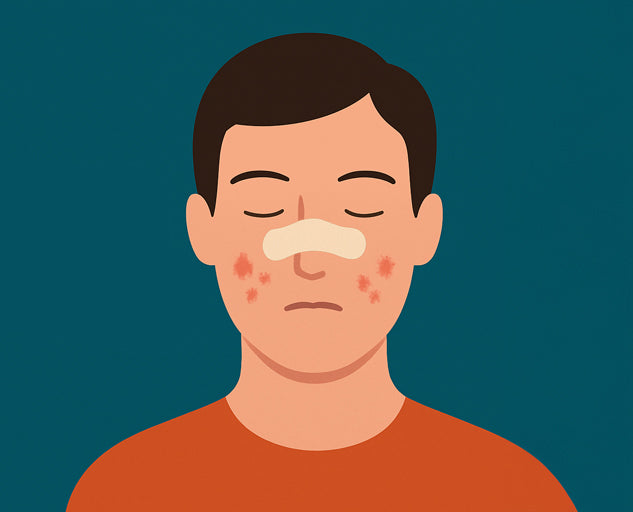The beginnings in the 1990s
The invention of modern nasal strips is often attributed to the Breathe Right brand, which was introduced in the US in the early 1990s. They were originally developed to provide gentle, external nasal support—all without medication.
Technically, they consist of a flexible patch with integrated plastic strips that gently adhere to the nostrils. (What are nasal patches? )
Inspiration from equestrian sports

Interestingly, some innovations originated from two veterinarians— Jim Chiapetta and Edward Blach . They observed that racehorses' nasal passages narrow significantly under stress. They subsequently developed an external support system for horses ( Flair Strips )—inspired by the technology used in human nasal strips.
They later licensed the technology to Breathe Right before launching Flair Strips, their own product for equestrian athletes, in 2001. ( Flair Strips – Our Story )
Technical developments
Over time, nasal patches became more skin-friendly, more durable and less noticeable.
A US patent ( US9204988B1 ), for example, describes a design with a non-sticky center section – this reduces skin irritation, improves placement, and increases the stability of the patch. ( US Patent 9204988B1 )
Other manufacturers, such as Intake Breathing Technology LLC, have also developed innovative nasal delivery systems in recent years, some of which are reusable. ( Intake Breathing – Patents )
Modern areas of application
 While nose patches were initially used almost exclusively in sports, they can now be found in many areas:
While nose patches were initially used almost exclusively in sports, they can now be found in many areas:
- In everyday life, e.g., when traveling
- During physical exertion
- For special occasions where an inconspicuous look is important
How do you use nasal patches correctly?
Sustainability and packaging
Modern manufacturers are increasingly turning to sustainable packaging solutions. AirStripes nasal strips, for example, are shipped in a space-saving envelope, thus reducing packaging material.
Cultural and sporting distribution worldwide
Nasal patches have become established in various regions of the world over the past decades – often with very different focuses.
North America – Popularity through professional sports
In the US, nose strips became popular primarily through football players who wore them during games. They can also be seen occasionally in baseball and basketball. Media coverage in major sports leagues led to a sharp increase in popularity. ( Wikipedia – Nose strip )
Asia – Use in baseball and cycling
In Japan and South Korea, nasal patches are mainly used by baseball players, while in China and Taiwan, cyclists and track and field athletes are also among the users.
Europe – From the racetrack to everyday life
In Europe, nasal strips are particularly popular in cycling and running sports. Thanks to media coverage, they have also found everyday use—for example, while traveling or during longer outdoor activities.
Comparison to similar aids
In addition to nasal patches, there are other products that act externally or internally on the nose. A direct comparison shows how nasal patches differ from other solutions.
Nose clips

- Usually used when swimming to prevent water from entering
- Sit on the bridge of the nose, are reusable
- No adhesive surface, therefore often less skin-sensitive, but less stable in everyday life
Nasal patches / nasal strips
- Self-adhesive, flexible, discreetly wearable
- Disposable product, therefore hygienic
- Various sizes and designs available – e.g. AirStripes nasal strips in transparent or skin-colored
Internal resources
- E.g. nasal dilators made of silicone that are inserted into the nostrils
- Reusable, but often less inconspicuous
- Must be cleaned regularly
outlook
The future of nasal strips is likely to be characterized by more skin-friendly materials, optimized adhesive technologies, and reusable designs. The trend toward more transparent nasal strips is also expected. and individually customizable designs will continue to increase.




